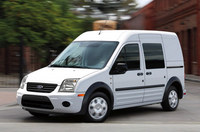2010 Ford Transit Connect Review
SEE ALSO: FORD BUYERS GUIDE
THE AUTO PAGE
By JOHN HEILIG
SPECIFICATIONS
Model: 2010 Ford Transit Connect
Engine: 2.0-liter I4
Horsepower/Torque: 136 hp @ 6,300 rpm/128 lb.-ft. @ 4,750 rpm
Transmission: 4-speed automatic
Wheelbase: 114.6 in.
Length/Width/Height: 180.6 x 70.7 x 79.3 in.
Tires: P205/65R15
Cargo volume: 135.3 cu. ft.
Fuel economy: 22 mpg city/25 mpg highway/23.0 mpg test
Fuel capacity: 15.1 gal.
Curb weight: 3,470 lbs.
Sticker: $26,215 (includes $695 destination and delivery charge
and $3,680 in options)
The Bottom Line: The Transit Connect is a good product with infinite possibilities as a camper, delivery van or large people carrier. Our tester had some deficiencies, but the potential is there.
Even with globalization of the auto industry, who would expect that a vehicle made in Turkey would have an impact? But I felt as soon as I saw the Ford Transit Connect that here was a vehicle that connected with me. Unlike the larger Dodge/Mercedes/Freightliner Sprinter, the Transit Connect is smaller. Yet it has just as much potential, both commercially and in general use, as the larger Sprinter.
Our tester was a basic TC, with three paneled sides and no windows. Hence, there were no rear view mirrors to see what's behind you. The driver must learn how to drive using only the exterior rear view mirrors, but it isn't a steep learning curve. A back-up camera would have helped, because I found myself parking way too far away from the rear line. We discovered later that there was a reverse sensing system that would beep if we got too close to objects behind us.
Also, this was a commercial vehicle, so there were no visor mirrors for my wife and me to check how beautiful we are. We coped.
Our tester had two front bucket seats. this is great, because the children couldn't ask us to care for their children that week. The cargo area behind the front seats was 135.3 cubic feet, or 72 inches long by 48 inches wide at the wheel housings and 54 inches high. The cargo area has three tie downs plus body panels that can serve as tie-down bases.
Access to the cargo area was through sliding door son both sides and rear doors that open 180 degrees. A rubber mat covered the cargo floor.
All electronic systems boxes were exposed on the sides of the TC.
The front seats had surprisingly good side support. We never took the TC out on our favorite hill climb course, because with the high aspect ratio of the vehicle, lean on hard cornering was predicated.
Storage areas in front included good door pockets, but with no "bottle" room, a small cubby ahead of the shifter and a nice meshed storage area above the visors that was about 12 inches deep, six inches high and the width of the vehicle.
Our tester had a simple instrument panel with a large tachometer and speedometer and smaller water and fuel gauges in between. There was a small information panel below the water and fuel gauges.
The navigation screen readout had a nice screen. It also functioned as a computer screen for the onboard computer ($1,395 option). We also had a USB input on the dash (for the computer) and an AUX input by the shifter.
For companies that don't need huge delivery vans, the Ford Transit Connect is a logical choice over the smaller Scion xB or Chevrolet HHR vehicles often used. Also, there's an enormous potential for building a small camper/motor home/RV on the chassis (with windows, of course).
© 2010 The Auto Page Syndicate



